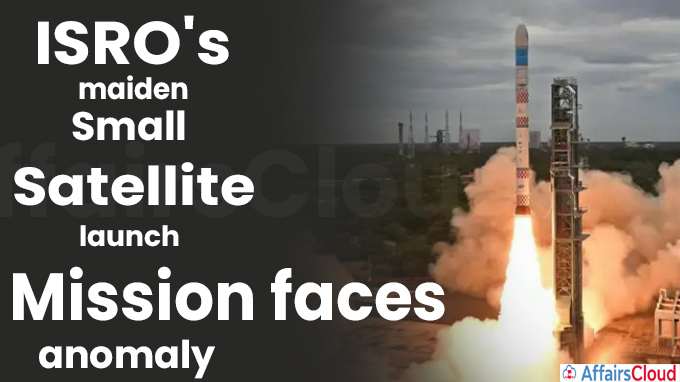
On August 7, 2022, the Indian Space Research Organisation (ISRO) launched its first 34 metre tall Small Satellite Launch Vehicle (SSLV) to place an Earth Observation Satellite (EOS-02) and students satellite AzaadiSAT. It was launched from Satish Dhawan Space Centre (SDSC), Sriharikota, Andhra Pradesh (AP).
- SSLV was developed by ISRO to cater the launch of up to 500 kg satellites to Low Earth Orbits on launch-on-demand basis.
- The maiden launching mission of SSLV was called as SSLVD1/EOS-02 mission.Although the first attempt at SSLV was successfull,it was failed to reach the intended orbit. SSLV-D1 placed the satellites into 356 km x 76 km elliptical orbit instead of planned 356 km circular orbit.So satellites are no longer usable.
- SSLVD2 mission will be implemented by ISRO to overcome the failure.
About SSLV:
i.SSLV-D1 is a 34 m tall, 2 m diameter vehicle having a lift-off mass of 120 t (tonne).It is capable of launching Mini, Micro, or Nanosatellites (10 to 500 kg mass) to a 500 km planar orbit.
- SSLV is configured with three solid stages — 87 tonne; 7.7 tonne and 4.5 tonne
ii.It provides low-cost access to space on demand basis besides offering low turn time, flexibility in accommodating multiple satellites, besides minimal launch infrastructure requirements.
iii.With this launch, India presently has three operational launchers -Polar Satellite Launch Vehicle (PSLV), Geosynchronous Satellite Launch Vehicle (GSLV) and Small Satellite Launch Vehicle (SSLV).
The SSLV is 34m tall, about 10m less than the Polar Satellite Launch Vehicle (PSLV) and it has a vehicle diameter of two metres as compared to 2.8 metres of PSLV. SSLV has a lift off mass of 120 tonne while PSLV has 320 tonnes, which can carry payloads up to 1,800 kgs.
SSLV suffered Anomaly:
The SSLV was supposed to place the EOS-02 andAzaadiSA into the intended 356 kms circular orbit. However, SSLV suffered an anomaly which resulted in the deviation on its path thereby becoming no longer usable.
- Scientists were unable to receive data from the rocket even after the payloads got separated from the launch vehicle.
- It placed the satellites into 356/76kms low earth orbit due to an anomaly.
Key Points:
i.The 76 kms elliptical orbit was the lower most point and closer to the surface of the earth. The satellites placed in such an orbit will not stay for longtime due to the atmosphere and will come down.
ii.To probe into the incident, ISRO has set up an expert committee which will identify the specific problem and undertake a detailed evaluation.
iii.It is not the first time ISRO faced a setback on its maiden launch mission. PSLV (Polar Satellite Launch Vehicle) was also not successful in its first flight on September 20, 1993. After its first successful launch in October 1994, PSLV emerged as the reliable and versatile launch vehicle of India.
About Payloads:
EOS-02:
Weighing 135kgs, EOS-02 was planned to be placed into a low earth orbit of about 350 kms to the equator. It is designed by ISRO and offers advanced optical remote sensing operating in infra-red band with high spatial resolution.
- It is meant for agriculture, forestry and disaster management.
AzaadiSAT:
AzaadiSAT is a 8U Cubesat weighing around 8 kilograms. It carries 75 different payloads each weighing around 50 grams.
- AzaadiSAT was built by 750 girl students from 75 schools across the country to remark the 75th Anniversary of India Independence and the mission was created to give girls from rural regions the opportunity to learn the fundamentals of spaceflight, as part of the United Nations theme of “women in space”.
- The payloads were integrated by the student team of ‘Space Kidz India’.
- The payloads include a UHF (Ultra High Frequency)-VHF (Very High Frequency) Transponder working in ham radio frequency to enable voice and data transmission for amateur radio operators, a solid state PIN diode-based Radiation counter to measure the ionising radiation in its orbit, a long-range transponder and a selfie camera.
Recent Related News:
i.MapmyIndia, subsidiary of CE Info Systems Ltd, has announced a partnership with India’s space agency, ISRO, to enhance the quality of its 3D maps. MapmyIndia is working on new maps as part of their metaverse venture.
ii.On June 22, 2022, the NewSpace India Limited’s (NSIL), GSAT (Geosynchronous Satellite)-24 satellite was successfully launched through Ariane-5 Rocket/Ariane Flight VA257 by French company Arianespace from the Guiana Space Centre, in Kourou, French Guiana in South America. This is India’s 1st ‘demand-driven’ communication satellite. GSAT24 is built by ISRO for NSIL.
About Indian Space Research Organisation (ISRO):
Establishment– 1969
Chairman– Sreedhara Panicker Somanath
Headquarters– Bengaluru, Karnataka




